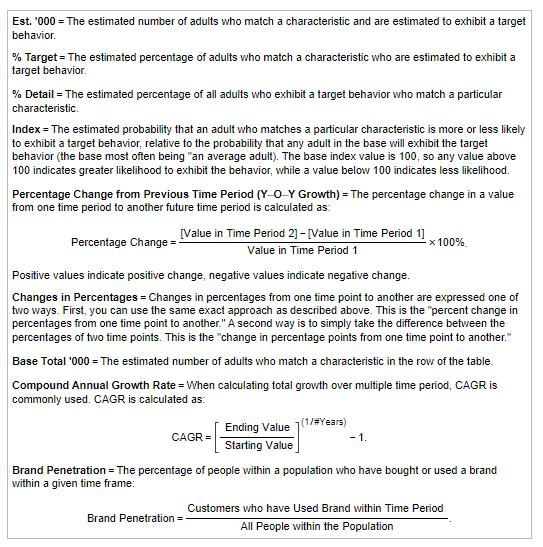Answered step by step
Verified Expert Solution
Question
1 Approved Answer
How do different clothing retailers relate to different income groups? You are a consultant for a national chain of clothing stores. This company has




How do different clothing retailers relate to different income groups? You are a consultant for a national chain of clothing stores. This company has asked you to help them understand how popular these competitors are among different income groups of adults. Using the following report, you created the report about different income group' shopping propensity across 5 national retailers who sell, among other things, clothing. Click the icon to view the Help Menu. Click the icon to view the first part of the report about different income group' shopping propensity. Click the icon to view the second part of the report about different income group' shopping propensity. Review the table provided, then answer the following questions. In some instances, the necessary information may be provided directly to you in the table. However, in most cases, you will need to calculate the answers using the provided information. 38.7% of all people who recently shopped at Retailer E live in homes that make at least 75k. (Round to one decimal place.) % of all people who live in a household that makes over 150k shopped at Retailer E in the last 3 months. (Round to one decimal place.) HH Income < 30k 30 - 49,999k 50 -74,999k 75 - 149,999k 150,000k + All US Adults Base Total (millions) 56.9 44.8 42.2 69.4 26.3 239.6 Retailer A 12.1 12.6 20.5 36.2 18.6 100.0 Retailer B 13.7 12.4 27.9 18.8 27.2 100.0 % Detail Retailer C 15.1 17.3 21.3 30.2 16.1 100.0 Retailer D 12.8 13.8 17.4 38.4 17.6 100.0 Retailer E 23.4 20.3 17.6 24.5 14.2 100.0 HH Income < 30k 30 - 49,999k 50 -74,999k 75 - 149,999k 150,000K + All US Adults Base Total (millions) 56.9 44.8 42.2 69.4 26.3 239.6 Retailer A 14.6 17.4 25.9 70.9 25.5 34.6 Retailer B 7.2 13.6 16.9 21.7 24.3 16.2 % Target Retailer C 7.3 8.6 10.8 14.6 12.0 10.8 Retailer D 19.5 26.8 34.8 46.3 13.5 30.7 Retailer E 57.5 59.3 62.2 55.2 49.9 57.2 Est. '000 = The estimated number of adults who match a characteristic and are estimated to exhibit a target behavior. % Target = The estimated percentage of adults who match a characteristic who are estimated to exhibit a target behavior. % Detail = The estimated percentage of all adults who exhibit a target behavior who match a particular characteristic. Index = The estimated probability that an adult who matches a particular characteristic is more or less likely to exhibit a target behavior, relative to the probability that any adult in the base will exhibit the target behavior (the base most often being "an average adult). The base index value is 100, so any value above 100 indicates greater likelihood to exhibit the behavior, while a value below 100 indicates less likelihood. Percentage Change from Previous Time Period (Y-O-Y Growth) = The percentage change in a value from one time period to another future time period is calculated as: Percentage Change = [Value in Time Period 2]-[Value in Time Period 1] Value in Time Period 1 Positive values indicate positive change, negative values indicate negative change. Changes in Percentages = Changes in percentages from one time point to another are expressed one of two ways. First, you can use the same exact approach as described above. This is the "percent change in percentages from one time point to another." A second way is to simply take the difference between the percentages of two time points. This is the "change in percentage points from one time point to another." Base Total '000 = The estimated number of adults who match a characteristic in the row of the table. Compound Annual Growth Rate = When calculating total growth over multiple time period, CAGR is commonly used. CAGR is calculated as: CAGR = x 100% Ending Value (1/#Years) Starting Value Brand Penetration = - 1. Brand Penetration = The percentage of people within a population who have bought or used a brand within a given time frame: Customers who have Used Brand within Time Period All People within the Population
Step by Step Solution
★★★★★
3.46 Rating (159 Votes )
There are 3 Steps involved in it
Step: 1
According to the table the percentage of all people who recently shopped at Retailer ...
Get Instant Access to Expert-Tailored Solutions
See step-by-step solutions with expert insights and AI powered tools for academic success
Step: 2

Step: 3

Ace Your Homework with AI
Get the answers you need in no time with our AI-driven, step-by-step assistance
Get Started


